Today we are going to review the cheapest 8-port 2.5GbE switch we could find, the TP-Link TL-SH1008 (V1). This switch retails for about $119 on AliExpress with free (slow) shipping. We have been focusing a lot of review energy this year on 2.5GbE networking, and one of the big comments we get is that 2.5GbE switches are too expensive. With that, we are going to review the cheapest unit out there and we certainly learned why.
TP-Link TL-SH1008 Hardware Overview
We actually also have the 8x 10GbE SFP+ cousin of this switch. Patrick, our Editor-in-Chief, wanted to do one combined video instead of two so here that is:
As always, we suggest opening that in its own YouTube browser, tab, or app for a better viewing experience. We demonstrate the power consumption in more detail in the video.
The TP-Link TL-SH1008 itself is designed to be a small desktop unit. Most likely if you wanted to rackmount it, you are using a shelf. The front of the switch only has a power LED and the model number.
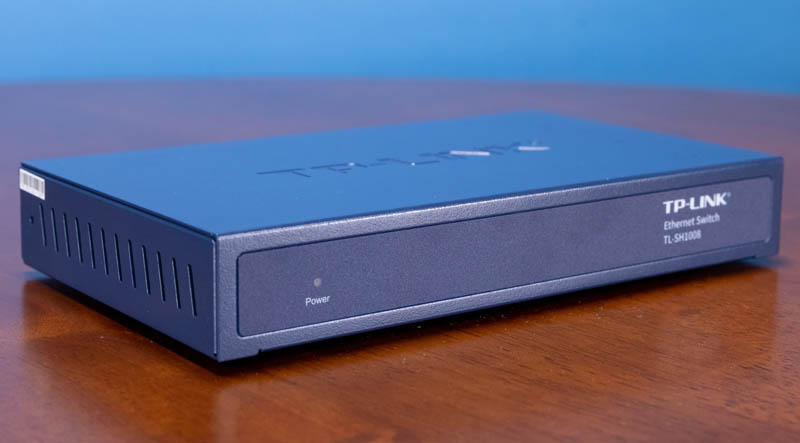
The side of the switch has air vents. You can see a single screw hole, so there is not a secure 3-4 screw mounting point for rackmount rails on this one. One positive is that this unit is a metal chassis rather than a plastic case we see on many low-cost switches these days. That adds cost to something that is designed to be cheap.
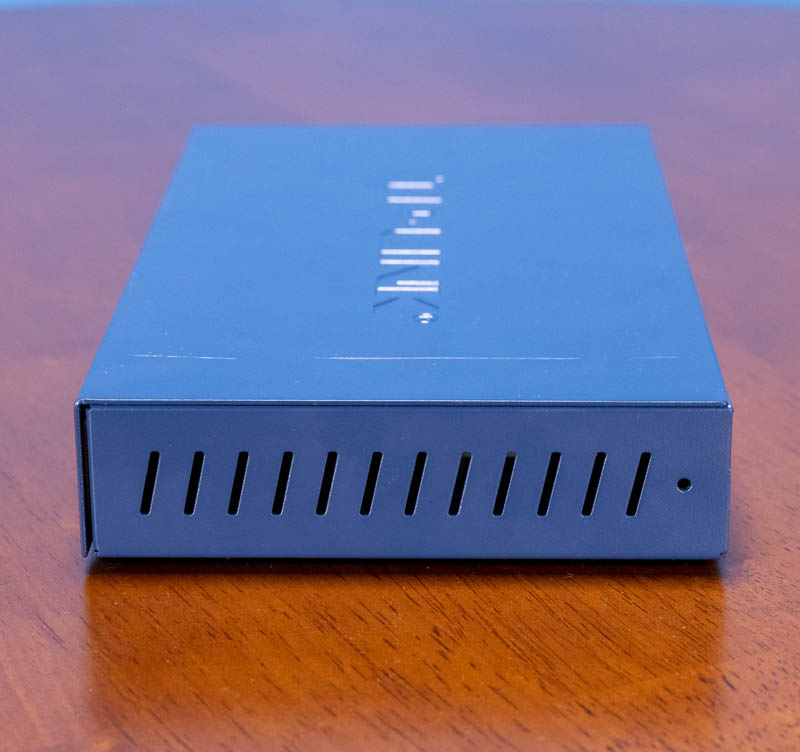
The main side of the switch has 8x RJ45 ports. These are all 2.5GbE ports that can negotiate down to 1GbE speeds. There is also the 12V 2A DC power input.
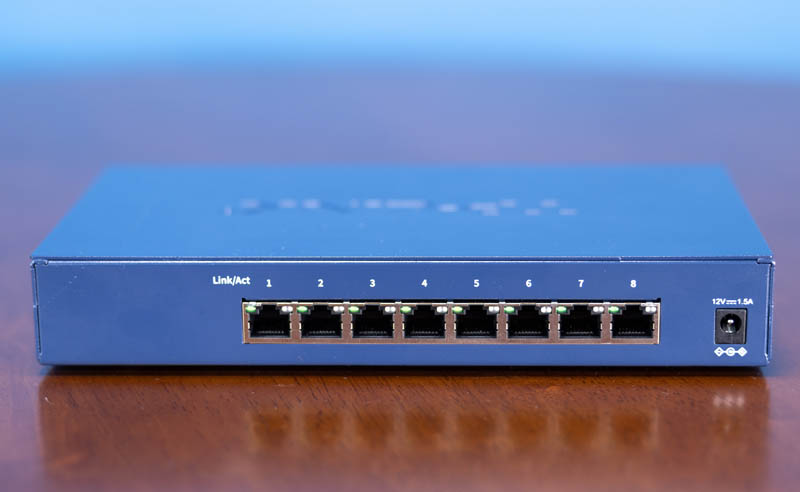
On the bottom of the switch, we see two stickers. One sticker is a tampering seal. The second has the model number and revision. This is a V1 switch.
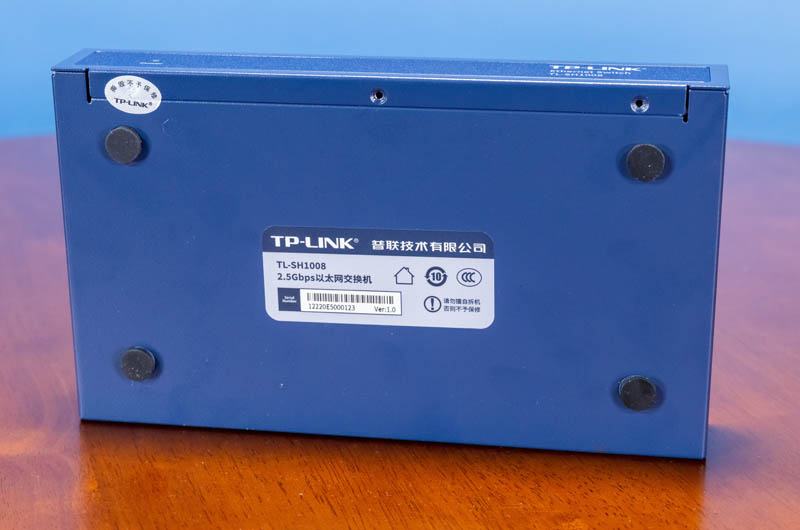
Inside the switch, we see that there are no fans. We have a switch chip and then the PHYs and circuits for the 8x 2.5GbE ports.
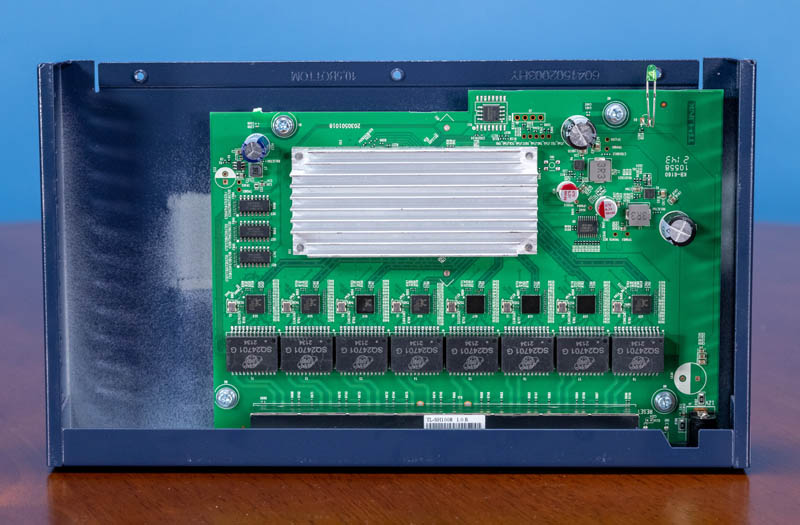
This is a simple unmanaged switch, so there is just not that much going on here. Next, let us get to the performance before looking at power consumption.
TP-Link TL-SH1008 Performance
In terms of performance, we simply hooked up some of the fanless 2.5GbE units like the two fanless Intel Celeron N5105 4x 2.5GbE options we reviewed to the switch and just bounced iperf3 traffic from port to port.
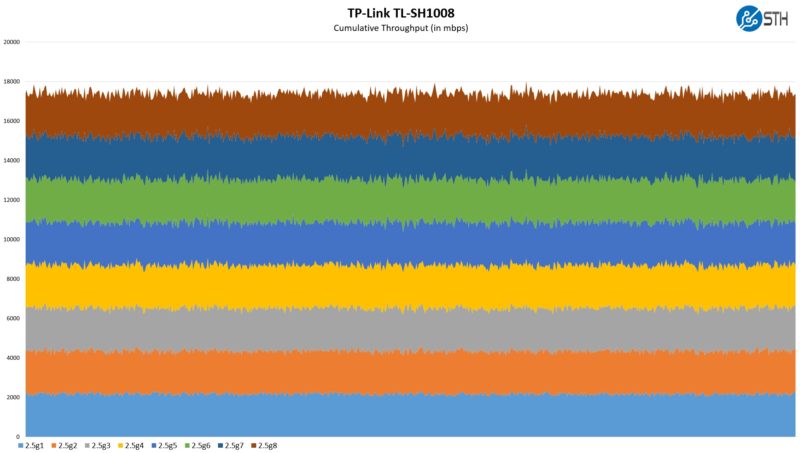
While we do not get 20Gbps, each port was well over 2Gbps and so we are saying this was operating at 2.5GbE speeds. This is certainly closer to 20Gbps (8x 2.5Gbps) than 8Gbps (8x 1Gbps) when the switch is fully loaded.
Next, let us get to the power consumption and noise.

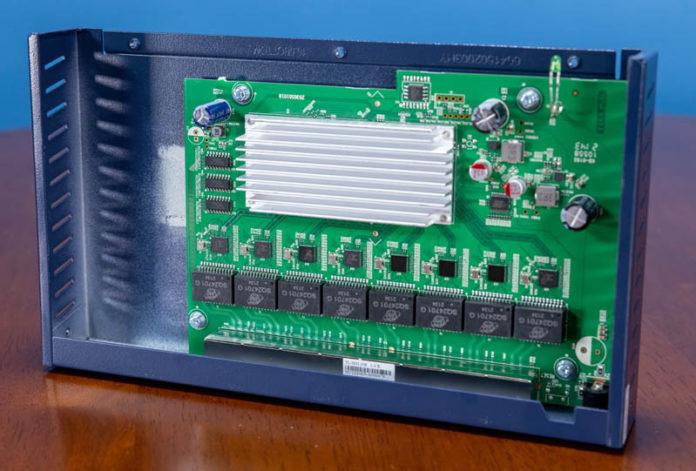



re: … these do not have FCC, UL, and other certifications …
I guess I’m not too surprised that these get past Customs, but I would also expect that they are actually illegal in some US locales, and in any case might be a liability risk for whoever approved the buy (as later explained to them by the fire marshall).
… speaking as someone who used to be a product manager for a US brand, and wouldn’t dream of sourcing an OEM gadget that lacked any required certs for any intended market.
Any word on what lives under that heatsink?
This particular version seems like one to skip; but it clearly implies that 2.5GbE equivalents to the now ubiquitous cheap gigabit unmanaged switch chips are hitting the scene, and it would be interesting to know who is making them.
thanks for the article and the honest review. Why did you give it “8” for performance
given that its performance was sub par?
“[The TP link is] around $60 cheaper than the also unmanaged [TRENDnet]. That is 33% less expensive so it is hard not to say that, on a per-port basis, this is not cheaper.”
I’m having a hard time understanding what that means. I assume it means the TP-Link is cheaper, but the following sentence suggests it’s easy to say the TP-Link is more expensive! What happened to never not using no double-negatives??
Dude, Bob, you’ve no idea what you’re talking about. Clearly you were not good at your job.
UL is a private lab with private specs. There are zero legal requirements in the us for product safety. Market requirements only.
For FCC, only part 15b is needed. The is no FCC license for non radio devices.
TP-Link isn’t a fly bye night company. They literally only need 15b to sell it
It’s sketchy and you don’t recommend… Still give it an 8 score… Honestly guys, why do you even score things half the time?
Example –
Design & Aesthetics: (your score 7.5) It is a chunky little metal block. It looks bad, has no mounting holes, no fan, no lights, nothing really good other than it’s metal and holds the parts. My score: 7 (average)
Performance: (your score 8.5) It doesn’t do full line speed 2.5Gb on each port through testing, it had issues auto negotiating connections, and it is litetally next to bottom of the barrel for basic speeds in desktop switching products (1/2.5/5/10Gb are readily available these days). My score: 5 (subpar)
Feature Set: (your score 7.5) it’s a dumb switch (unmanaged) and doesn’t have any additional features, period. My score: 5 (subpar)
Value: (your score 8.5) It’s the cheapest option available, and it works. Simple. My score: 10
My Score: 6.75
Would not recommend for any use other than homelab/experimental.
Richard C – The performance is not that bad actually. It is similar to what we see on other cheap switches in this class. Slightly lower than expected, but we were running like 2.2Gbps on the ports even fully loaded.
Micah – You can make your own scoring system and site. Performance is similar to other switches with that setup. Feature set this is being sold as an unmanaged switch. Unmanaged is its own market defined by not being managed. I am not sure how we ding a product for doing exactly what it says. Giving it a 5 would mean you are comparing it to managed switches in a different segment. That is like comparing a Rolls Royce to a F150 or a Cessna Citation.
I bought one of these. Here’s the story. It works OK for $120. I think I got mine for $116 with Ali coupons. For $120 an 8/10 is exactly what I’d give it.
I understand that, which was kind of my point. You gave it a decently good score because the expectation was so low to begin with for this product. What about the other switches that are far more expensive and got just about the same scores? Based on this scoring style you state (again by score) that this switch is as good as any other 8, feature for fearure. But it clearly isn’t? Or is it?
Don’t get me wrong, I really love all these reviews. Which is why I find it hard to process the scores into any actionable outcomes when it comes to comparing the products. If everything is an 8+ simply because “It does what they say it does,” then were is the deviations and recommendations (or not)? I’ll just continue to enjoy the content and ignore the scores, no big deal.
Malvineous – That sentence also took me like 5-6 re-reads to parse properly. It’s a double negative, which basically should read more like:
> “On one hand, it is only $119, around $60 cheaper than the also unmanaged TRENDnet TEG-S380 8-port 2.5GbE switch we reviewed. That is 33% less expensive so it is easy to say that, on a per-port basis, this is cheaper.”
…which isn’t a great sentence to begin with, but at least it’s more readable! ;)
—
As for the comments regarding the rating, I’m gonna have to agree: you can’t give an 8 to something you don’t recommend. You can score it high on value and on something else, but if you don’t recommend something, the score needs to be low. Otherwise the score is useless and you’re better off not giving it… ¯\_(ツ)_/¯
Micah > then w(h)ere is the deviations and recommendations
The products that were brought to review are at least somewhat decent. You don’t expect them to get a trash product and then give it a 3 or something. Things that appear here are at least somewhat good. Not being recommended for all scenarios, but these are perfectly fine for a small homelab if the reader happens to live in China and can source it cheaper, or has a tight budget and don’t want to stretch to get a better option.
Since scoring has come up again, I think (as in just my opinion) I would eliminate it. Daily site reader here, but I haven’t looked at those numbers in years. They just don’t even register in my brain as being there, because 9 times out of ten, the number is a 9.
(WTF is up with the captcha today?)
2.5Gbps is a dead end. 5Gbps will hang around for awhile, but really 10GbE should be at the price point of general availability. 1GbE was considered a massive luxury back in 1998 and 25 years later we haven’t changed? Why?
Corporate America and their network teams have convinced themselves that end users “have no need” for higher copper based speeds. It was the same argument in 2010 when they told everyone that 100Mbps was enough for everyone. If big corporate IT won’t order en masse, then no one else will either.
So we remain stuck in this network twilight zone.
The issue with mass market adoption of faster than gigabit networking is due to chicken and egg problem and also the fact that it took this long to get chips developed that don’t generate massive amounts of heat and gobble up power like the older 10GBASE-T cards do.
I’m just a bit baffled that they wasted so much time with 5Gbps and 10Gbps for home/soho when 2.5Gbps is clearly the next logical step and mass market speed.
Most people still don’t need faster than 1 Gbps if all they do is browse the internet.
Smart TVs are still sold with 100Mbit Ethernet interfaces because at this scale the pennies saved per chip (they use ARM SoCs that only have a 100Mbit interface) adds up. Since more people connect using Wifi anyways there is no point.
Still 10Gbit is cheaper now than it has ever been and switches are available from TrendNET, QNAP, Netgear, Mikrotik and so on that fit a home enthusiast budget.
2.5Gbps is getting there, but 10Gbps is still considered a niche and those that need it can pay up too.
Only when manufacturers stop making 1GbE chips in order to save money on production lines will 2.5GbE fully replace 1GbE as the new mainstream. And then maybe 1GbE will take the place that 100MbE has now as the ultra cheap just-enough networking alternative.
Guys. There is a good purpose and practicality to examining these switches, even if they are somewhat cheap. The utility they provide does help with mainstream adoption, albeit in slower intervals, as the “cheaper” moniker makes it less appealing.
That being said, this is a good thing. We want and frankly NEED these types of devices to start showing up in the off-brand. Eventually, companies will start making good value pieces that will drive value AND cost-effectiveness. Until then, these will have to suffice.
As I predicted a while back, when STH started looking at these 2.5Gb devices, we will inevitably see a wider adoption of this speed as time goes on. It just makes sense for lower mainstream consumers. 10Gb still sounds and feels geeky to the common user. Even if we STH people think its quite commonplace. I will tell you now. It really isnt. Most people think Wifi is normal, and 1Gb is fast. They hear about 2.5Gb and they think cutting edge.
Trust me.
So now we start to get these cheaper rung devices popping up, lets be happy. There is merit in the celebration of these small bits of tech, as it will herald a company to begin looking at an otherwise untapped market. I think it’s time we will see more and more of these cheaper things.
Let’s not get caught up on recommendations and status/scoring right now. Let’s focus on utility and access.
This is a good thing. We will see more of this coming soon.
You can’t give a product an 8, and then say it is not recommended. That is absurd.
I completely understand why you get so much criticism on the rating numbers, it is well deserved.
Don’t sweat people like Jason STH. He obv didn’t read why it’s not recommended. It makes sense to me how a product can be an 8/10 but you’re going to recommend a higher rated product that you flashed in the video. Internet trolls don’t read.
I gotta agree with the other comments, I don’t get why you all bother to score stuff. I feel like half the time I have no idea why you rate what you rate. In the end it doesn’t really seem to matter. I don’t like the fact that when someone gives you constructive criticism, your response is ‘make your own site’. No, we like this site, and we are suggesting you either a.) do a better job explaining how you score or b.) get rid of the scores.
Timberlink – you’re definitely in the minority, and because someone doesn’t agree with you hardly makes them an “Internet troll”. The scoring system on this site has never made any sense. It’s like if it powers on, it automatically gets at least a 7.
I don’t think big companies like TP-LINK put products into production that’d get less than 7. Most companies wouldn’t. On review sites I look at the scale as like 8-10 because <7 won't go to production. <8 won't get reviewed. It's the sites that have 9.5-10's only that I'm more skeptical of. I'm also skeptical of the sites that have 150 words, stock images, and all 9.5-10's. If you've watched the video, they're doing power consumption live and there's internal photos to see as well. If you don't like this scale, they've got the raw materials for you to give it your own personal rating.
I think that 8.5 for value is low but I'd agree with the rest. Others like Startech that have switches that are like these rebranded are like $180-200 so $116 I'd say is about the best value.
You’re comparing the 10G switch to the MicroTik CRS309-1G-8S+, which is managed and clearly a different beast. Also, it is currently not available (on Amazon at least).
You mentioned that it would be worthwhile to spend another $60+ would be worthwhile to get management features, but you didn’t mention the upgraded TP-Link switch that offers these features at $240 shipped from Amazon today: TP-Link TL-SX3008F
Maybe another piece of inexpensive hardware to review?
Timberlink, I most certainly did read the article and understand why they don’t recommend it – so stop with the troll/name calling.
My point is that the rating system is fubar, and I stand behind that statement.
So what’s better a cheap 2.5GbE switch or one of these 2.5GbE mini pc’s running as a switch?
What is the main chip in this? Is it a real switch chip at all? Kinda looks like this is using a basic cpu under than heatsink and connecting to eight Realtek nic chips from the pictures.
Amazing and detailed review, congrats! I won’t enter the “scoring” debate, but something about this product truly bugs me:
– no FCC, UL, or any other certification
– not sold on Amazon or any other retail store, only on AliExpress and similar marketplaces from unknown sellers
– product not listed or mentioned anywhere on TP-Link’s website
How can you (or anyone) be sure this is actually a TP-Link product and not a “bootleg”? I mean, this would explain all the above points…
I bought one from Aliexpress based on your review. The performance is pathetic . I get 980Mbps Iperf speen through my old Netgear switch . This Sh1008 is only doing 400Mbps.
Even connecting a Wifi6 2.5G EAP650 to it doesnt get more than 400 Mbps.
Something is not right with it.
Bought three TL-SH1008 units from Aliexpress. Network became under heavy attack very quickly with disconnects, buffering, lag, even someone typing in a terminal in broken English making fun of “hamburger-eating Americans”. This absolutely shocked me! Seller (changhe Store) indicated that return period had expired (true) but also commented that unmanaged switches cannot be hacked. I do not know this to be true, but my confidence is shattered anyway. I am now trying to avoid all Chinese-made technology products (as difficult as it is) and buy exclusively from Amazon and other American retail chains. I recommend you the same if you care for your network security.